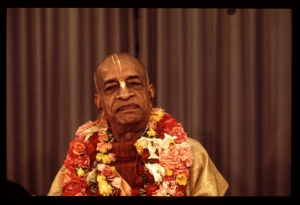CC Adi 2.91-92
(Redirected from CC Adi 2.91)

A.C. Bhaktivedanta Swami Prabhupada
TEXTS 91-92
- atra sargo visargaś ca
- sthānaṁ poṣaṇam ūtayaḥ
- manvantareśānukathā
- nirodho muktir āśrayaḥ
- daśamasya viśuddhy-arthaṁ
- navānām iha lakṣaṇam
- varṇayanti mahātmānaḥ
- śrutenārthena cāñjasā
SYNONYMS
atra — in Śrīmad-Bhāgavatam; sargaḥ — the creation of the ingredients of the universe; visargaḥ — the creations of Brahmā; ca — and; sthānam — the maintenance of the creation; poṣaṇam — the favoring of the Lord’s devotees; ūtayaḥ — impetuses for activity; manu-antara — prescribed duties given by the Manus; īśa-anukathāḥ — a description of the incarnations of the Lord; nirodhaḥ — the winding up of creation; muktiḥ — liberation; āśrayaḥ — the ultimate shelter, the Supreme Personality of Godhead; daśamasya — of the tenth (the āśraya); viśuddhi-artham — for the purpose of perfect knowledge; navānām — of the nine; iha — here; lakṣaṇam — the nature; varṇayanti — describe; mahā-ātmānaḥ — the great souls; śrutena — by prayer; arthena — by explanation; ca — and; añjasā — direct.
TRANSLATION
“‘Here [in Śrīmad-Bhāgavatam] ten subjects are described: (1) the creation of the ingredients of the cosmos, (2) the creations of Brahmā, (3) the maintenance of the creation, (4) special favor given to the faithful, (5) impetuses for activity, (6) prescribed duties for law-abiding men, (7) a description of the incarnations of the Lord, (8) the winding up of the creation, (9) liberation from gross and subtle material existence, and (10) the ultimate shelter, the Supreme Personality of Godhead. The tenth item is the shelter of all the others. To distinguish this ultimate shelter from the other nine subjects, the mahājanas have described these nine, directly or indirectly, through prayers or direct explanations.’
PURPORT
These verses from Śrīmad-Bhāgavatam (2.10.1-2) list the ten subject matters dealt with in the text of the Bhāgavatam. Of these, the tenth is the substance, and the other nine are categories derived from the substance. These ten subjects are listed as follows:
(1) Sarga: the first creation by Viṣṇu, the bringing forth of the five gross material elements, the five objects of sense perception, the ten senses, the mind, the intelligence, the false ego and the total material energy, or universal form.
(2) Visarga: the secondary creation, or the work of Brahmā in producing the moving and unmoving bodies in the universe (brahmāṇḍa).
(3) Sthāna: the maintenance of the universe by the Personality of Godhead, Viṣṇu. Viṣṇu’s function is more important and His glory greater than Brahmā’s and Lord Śiva’s, for although Brahmā is the creator and Lord Śiva the destroyer, Viṣṇu is the maintainer.
(4) Poṣaṇa: special care and protection for devotees by the Lord. As a king maintains his kingdom and subjects but nevertheless gives special attention to the members of his family, so the Personality of Godhead gives special care to His devotees who are souls completely surrendered to Him.
(5) Ūti: the urge for creation, or initiative power, that is the cause of all inventions, according to the necessities of time, space and objects.
(6) Manv-antara: the periods controlled by the Manus, who teach regulative principles for living beings who desire to achieve perfection in human life. The rules of Manu, as described in the Manu-saṁhitā, guide the way to such perfection.
(7) Īśānukathā: scriptural information regarding the Personality of Godhead, His incarnations on earth and the activities of His devotees. Scriptures dealing with these subjects are essential for progressive human life.
(8) Nirodha: the winding up of all energies employed in creation. Such potencies are emanations from the Personality of Godhead who eternally lies in the Kāraṇa Ocean. The cosmic creations, manifested with His breath, are again dissolved in due course.
(9) Mukti: liberation of the conditioned souls encaged by the gross and subtle coverings of body and mind. When freed from all material affection, the soul, giving up the gross and subtle material bodies, can attain the spiritual sky in his original spiritual body and engage in transcendental loving service to the Lord in Vaikuṇṭhaloka or Kṛṣṇaloka. When the soul is situated in his original constitutional position of existence, he is said to be liberated. It is possible to engage in transcendental loving service to the Lord and become jīvan-mukta, a liberated soul, even while in the material body.
(10) Āśraya: the Transcendence, the summum bonum, from whom everything emanates, upon whom everything rests, and in whom everything merges after annihilation. He is the source and support of all. The āśraya is also called the Supreme Brahman, as in the Vedānta-sūtra (athāto brahma jijñāsā, janmādy asya yataḥ (SB 1.1.1)). Śrīmad-Bhāgavatam especially describes this Supreme Brahman as the āśraya. Śrī Kṛṣṇa is this āśraya, and therefore the greatest necessity of life is to study the science of Kṛṣṇa.
Śrīmad-Bhāgavatam accepts Śrī Kṛṣṇa as the shelter of all manifestations because Lord Kṛṣṇa, the Supreme Personality of Godhead, is the ultimate source of everything, the supreme goal of all.
Two different principles are to be considered herein—namely āśraya, the object providing shelter, and āśrita, the dependents requiring shelter. The āśrita exist under the original principle, the āśraya. The first nine categories, described in the first nine cantos of Śrīmad-Bhāgavatam, from creation to liberation—including the puruṣa-avatāras, the incarnations, the marginal energy, or living entities, and the external energy, or material world—are all āśrita. The prayers of Śrīmad-Bhāgavatam, however, aim for the āśraya-tattva, the Supreme Personality of Godhead, Śrī Kṛṣṇa. The great souls expert in describing Śrīmad-Bhāgavatam have very diligently delineated the other nine categories, sometimes by direct narrations and sometimes by indirect narrations such as stories. The real purpose of doing this is to know perfectly the Absolute Transcendence, Śrī Kṛṣṇa, for the entire creation, both material and spiritual, rests on the body of Śrī Kṛṣṇa.